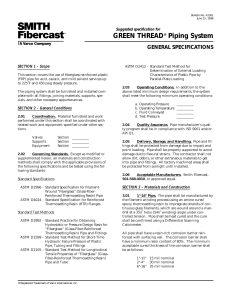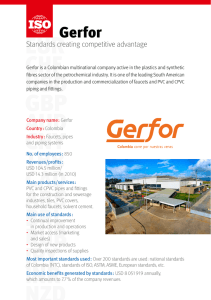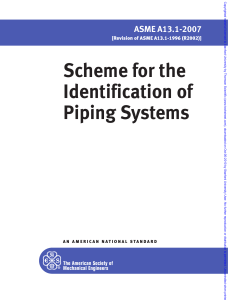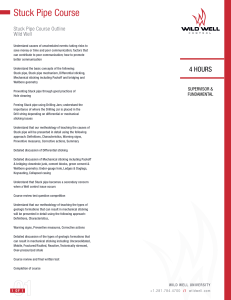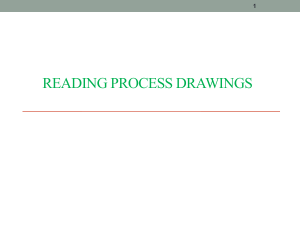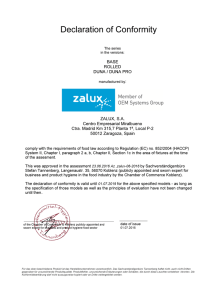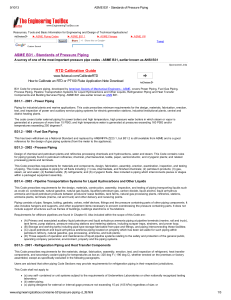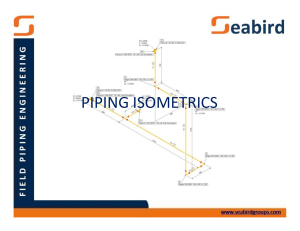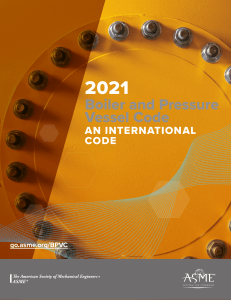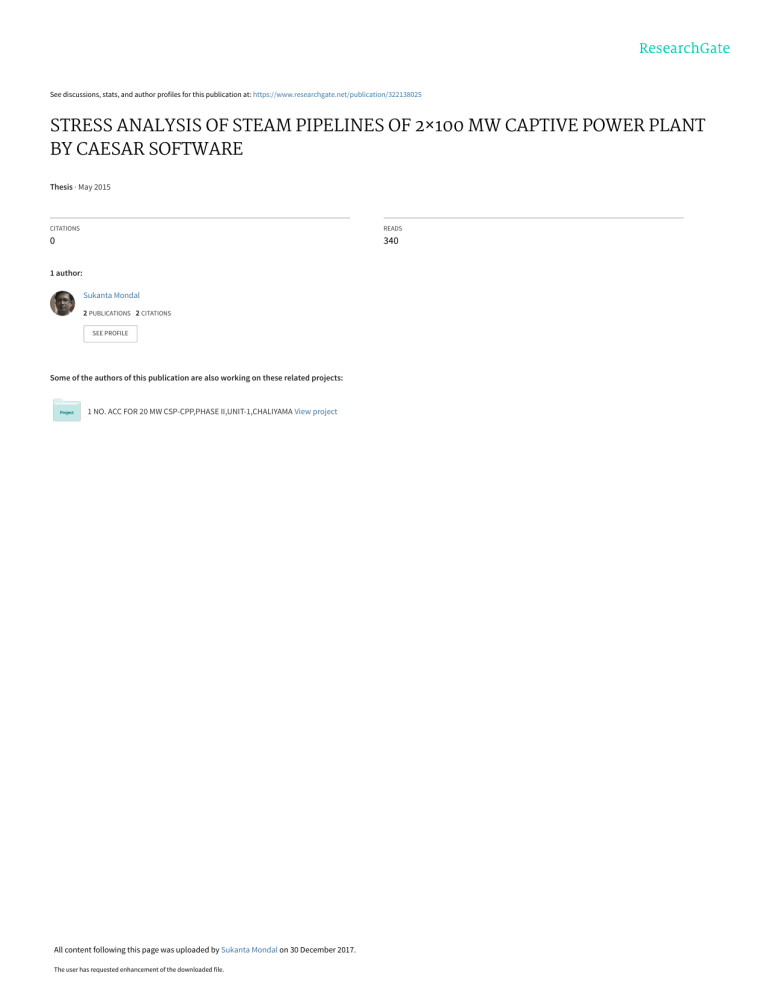
See discussions, stats, and author profiles for this publication at: https://www.researchgate.net/publication/322138025 STRESS ANALYSIS OF STEAM PIPELINES OF 2×100 MW CAPTIVE POWER PLANT BY CAESAR SOFTWARE Thesis · May 2015 CITATIONS READS 0 340 1 author: Sukanta Mondal 2 PUBLICATIONS 2 CITATIONS SEE PROFILE Some of the authors of this publication are also working on these related projects: 1 NO. ACC FOR 20 MW CSP-CPP,PHASE II,UNIT-1,CHALIYAMA View project All content following this page was uploaded by Sukanta Mondal on 30 December 2017. The user has requested enhancement of the downloaded file. STRESSANALYSISOFSTEAMPIPELINESOF2×100MW CAPTIVEPOWERPLANTBYCAESARSOFTWARE A thesis submitted toward partial fulfillment of the requirements for the degree of MASTER OF ENGINEERING in Water Resources and Hydraulic Engineering Course affiliated toFaculty of Engineering & Technology Jadavpur University submitted by SUKANTA MONDAL Exam Roll No: M6WRP15-15 Under the guidance of Dr. RAJIB DAS Assistant Professor School of Water Resources Engineering, Jadavpur University & Dr. SUBHASISH DAS Assistant Professor School of Water Resources Engineering, Jadavpur University School of Water Resources Engineering M.E. (Water Resources & Hydraulic Engineering) course affiliated to Faculty of Engineering & Technology Jadavpur University Kolkata 700032, India 2015 i Declaration of Originality and Compliance of Academic Ethics I hereby declare that this thesis contains literature survey and original research work by the undersigned candidate, as part of my Master of Engineering in Water Resources & Hydraulic Engineering in the Faculty of Interdisciplinary Studies, Jadavpur University during academic session 2014-15. All information in this document have been obtained and presented in accordance with academic rules and ethical conduct. I also declare that, as required by these rules and conduct, I have fully cited and referenced all material and results that are not original to this work. Name : Sukanta Mondal Exam Roll Number : M6WRP15-15 Thesis Title : STRESS ANALYSIS OF STEAM PIPELINES OF 2×100 MW CAPTIVE POWER PLANT BY CAESAR SOFTWARE Signature with Date : iii M.E.(WaterResources&HydraulicEngg.)courseaffiliatedto FacultyofEngineering&Technology JadavpurUniversity Kolkata,India Certificate of Recommendation This is to certify that the thesis entitled “STRESS ANALYSIS OF STEAM PIPELINES OF 2×100 MW CAPTIVE POWER PLANT BY CAESAR SOFTWARE”is a bonafide work carried out by Mr. Sukanta Mondal under our supervision and guidance for partial fulfillment of the requirement for the Post Graduate Degree of Master of Engineering in Water Resources & Hydraulic Engineering during the academic session 2014-2015. THESIS ADVISOR THESIS ADVISOR Dr. Rajib Das Assistant Professor School of Water Resources Engineering Jadavpur University Dr. Subhasish Das Assistant Professor School of Water Resources Engineering Jadavpur University DIRECTOR Prof. (Dr.) Asis Mazumdar School of Water Resources Engineering Jadavpur University DEAN Prof. (Dr.) Asis Mazumdar Faculty of Interdisciplinary Studies, Law & Management Jadavpur University v M.E.ȋWaterResources&HydraulicEngg.Ȍcourseaffiliatedto FacultyofEngineering&Technology JadavpurUniversity Kolkata,India CERTIFICATE OF APPROVAL ** This foregoing thesis is hereby approved as a credible study of an engineering subject carried out and presented in a manner satisfactorily to warranty its acceptance as a prerequisite to the degree for which it has been submitted. It is understood that by this approval the undersigned do not endorse or approve any statement made or opinion expressed or conclusion drawn therein but approve the thesis only for purpose for which it has been submitted. Committee of Final Examination for the evaluation of the thesis ** Only in case the thesis is approved. vii ACKNOWLEDGEMENT _____________________________________________________ I express my sincere gratitude to my supervisors Dr. Rajib Das and Dr. Subhasish Das under whose supervision and guidance this work has been carried out. It would have been impossible to carry out this thesis work with confidence without their wholehearted involvement, advice, support and constant encouragement throughout. They have not only helped me in my thesis work but also have given valuable advice to proceed further in my life. I would never forget the valuable help that I received from Prof. (Dr.) Asis Mazumdar, Dean, Faculty of Interdisciplinary Studies, Law & Management & Director, School of Water Resources Engineering, Jadavpur University. I also express my sincere gratitude to Dr. Debasri Roy, Associate Professor; Prof. (Dr.) Arunabha Majumder, Emeritus Professor and Dr. Pankaj Kr.Roy, Associate Professor of School of Water Resources Engineering, Jadavpur University for their valuable suggestions. I would also express my sincere thanks Mr. Biprodip Mukherjee, Research Scholar of School of Water Resources Engineering, Jadavpur University for his unconditional support and affection during my work. Thanks are also due to all staff of School of Water Resources Engineering and the Regional Centre, NAEB, Jadavpur University for their help and support. I am also grateful to my family and my son who have been my strength and inspiration throughout my M.E. course. Date : May, 2015 Place : Jadavpur University SUKANTA MONDAL (Exam Roll No: M6WRP15-15) ix ABSTRACT This study is on the real life operation of the Prakash Industries Ltd. Situated at Champa, Chattisgarh, India which is a captive power plant to support an associated steel plant. CAESAR II software developed by COADE, USA has been used in this study. CAESAR II is a PC-based pipe stress analysis software package that is developed, marketed and sold by Intergraph CAS. This software is an engineering tool used in the mechanical design and analysis of piping systems. CAESAR II is used to create a model of a piping system represented by simple three dimensional beam elements and to define the loading conditions imposed on the system. After giving necessary input data, CAESAR II produces results in the form of displacements, loads and stresses throughout the system. Additionally, CAESAR II compares these results to limits specified by recognized codes and standards. As per the data received the inputs are given and accordingly the results are interpreted in word and excel format. The whole network of service area is under Prakash Industries Ltd. and it consists of two waste heat recovery boilers and three turbines. In this study three dimensional deflections have been sorted out for the nodes of the whole steam piping system and their characteristics have been discussed. The code stress have also been matched with stress output reports and discussed. Finally the supports have been optimistically designed and selected out for the system to keep the deflections and the stresses under check keeping in view the economical and positioning factor of the supports. Here to minimise deflections and stresses, about 20 guide supports, 10 free supports, 10 hangers and 6 anchors were used which are user defined. xi CONTENT Page no Declaration Certificate of Recommendation Certificate of Approval Acknowledgement Abstract iii v vii ix xi CHAPTER 1 1.1 Introduction 1.2 Classification of pipe 1.3 Wall thickness 1.4 Schedule 1 1 2 2 CHAPTER 2 2.1 Objective of study 2.2Methodology 3 3 CHAPTER 3 3.1 Historical background 3.2 Review of earlier works 5 5 CHAPTER 4 4.1 Physical components of steam pipeline networks 4.1.1 Flange 4.1.2 Classification of flange 4.2 Valve 4.2.1 Valve selection 4.2.2 Function of valve 4.3 Stresses in steam piping system 4.3.1 Stress 4.3.2 Classification of loads 4.3.3 Classification of stress 4.4 Overview of CAESAR II software 9 9 9 11 12 14 14 14 15 16 19 CHAPTER 5 Study area 21 CHAPTER 6 Results & Discussions 23 CHAPTER 7 Conclusion 25 References Annexure I Annexure II 26 28 68 xiii CHAPTER 1 1.1 INTRODUCTION Pipes are the most delicate component in any process plant. They are also the busiest entities. They are subjected to almost all kinds of loads, intentional or unintentional. It is very important to take note of all potential loads that a piping system would encounter during operation as well as during other stages in the life cycle of a process plant. Ignoring any such load while designing, erecting, hydro-testing, start-up shut-down normal operation, maintenance etc. can lead to inadequate design and engineering of a piping system. The system may fail on the first occurrence of this overlooked load. Failure of piping system may trigger a Domino effect and cause a major disaster. Stress analysis and safe design normally require appreciation of several related concepts. An approximate list of the steps that would be involved is as follows. 1. Identity potential loads that would come on to the pipe or piping system during its entire life. 2. Relate each one of these loads to the stress and strain that would be developed in the crystals/grains of the Material of Construction (MOC) of the piping system. 3. Decide the worst three dimensional stress states that the MOC can withstand without failure. 4. Get the cumulative effect of all the potential, loads on the three dimensional (3-D) stress scenario in the piping system under consideration. 5. Alter piping system design to ensure that the stress pattern is within failure limits. The goal of quantification and analysis of pipe stresses is to provide safe design through the above steps. There could be several designs that could be safe. A piping engineer would have a lot of scope to choose from such alternatives, the one which is most economical, or most suitable etc. Good piping system design is always a mixture of sound knowledge base in the basics and a lot of ingenuity. 1.2 CLASSIFICATION OF PIPE Based on the method of manufacture, pipes could be classified as: A. WELDEDPIPE a) Electric Resistant welded (ERW): Pipes having longitudinal butt joint wherein coalescence is produced by the heat obtained from resistance of the pipe to flow of electric current in a circuit of which the pipe is a part and by applicable of pressure. 1 b) Furnace butt welded, continuous welded: pipes having longitudinal weld joints forge weld by mechanical pressure developed in passing the hot-formed and edge heated skelp through round pass weld rolls. c) Electric Fusion Weld (EFW): Pipes having longitudinal butt joint wherein coalescence is produced in the preformed tube by manual or automatic electric arc welding; weld may be single or double. d) Double Submerged arc welded: pipes having longitudinal butt joint produced by at least two passes, one of which is on the inside of the pipe. Coalescence is produced by heating with an electric arc or arcs between the bare metal electrode or electrode and the pipe. Pressure is not used and filler material is obtained from electrode. e) Sprial welded: Pipes having helical seam with either a butt, lap, lock-seam joint which is welded using either an electric resistance, electric fusion or double submerged are welding process. B.SEAMLESS PIPE: Pipes produced by piercing a billet followed by rolling or drawing or both. 1.3 WALL THICKNESS Prior to ASME B36.10 AND ASME B 36.19 thickness became effective, the pipes were manufactured as per the iron pipe standard (IPS) with wall thickness designations standard weight (STD), extra strong (XS) and Double Extra Strong (XXS). Subsequently schedule numbers were added as convenient designations. The pipe thickness is designated by schedule number and corresponding thickness is specified in the standard ASME B36.10 for carbon steel pipes and ASME B 36.19 for stainless pipes. 1.4 SCHEDULE Stainless steel pipes are available in schedule5S, 10S, 40S and 80s whereas Carbon steel pipe are available in schedule 5, 10, 20, 30, 40, 60, 80, 100, 120, 140, 160, STD, XS, XXS 2 REFERENCES ASME B36.10M- Welded and Seamless wrought steel pipe ASME B31.1-2007 Power Piping ASME M31.3-2008 Process piping ASME B16.5-2009, Pipe Flange and flange fittings ASME B16.9-2003, Factory made wrought butt welding fittings ASME B16.11-2009, Forged fittings, socket-welding and threaded. ASME B16.21-2005, nonmetallic flat gaskets for pipe flanges ASME B16.34-2004, Valve S-flanged, threaded, and welding end Chatterjee, B. (2011). Pipeline transient analysis of Mejia Thermal Power Station, DVC by HAMMER Software. M.E. Thesis. School of Water Resources Engineering, Jadavpur University, Kolkata: India. Das, S. (2006). Study of pipeline network system and temporal decay of chlorine for the water treatment plant at Dakshin Raipur, West Bengal. M.E. Thesis. School of Water Resources Engineering, Jadavpur University, Kolkata: India. Das, S., Roy, P.K. and Mazumdar, A. (2008). Analysis of pipe flow and headloss of a modeled network based on EPANET in a water treatment plant at Raipur, West Bengal. Journal of the Institution of Public Health Engineers, India, 2008-09(3), pp. 21-28. Das S., Mukherjee B. and Mazumdar A. (2013). Analysis of Hammer Head at Increased Flow Demand in Pipe Networks: A Case Study. International Review of Mechanical Engineering, 7(4), pp. 757-766. Jaman H. (2011). Modification of Hunter’s Curve in the Perspective of Water and Energy Conservation. M.E. Thesis. School of Water Resources Engineering, Jadavpur University, Kolkata: India. Mazumdar A., Jaman H. and Das S.(2013). Modification of Hunter's Curve in the Perspective of Water Conservation. Journal of Pipeline Systems Engineering and Practice. 5(1), pp. 04013007(1-9). doi: 10.1061/(ASCE)PS.1949-1204.0000150. Mukherjee, B. (2012). Pipeline design and analysis of distribution network of Dhapa water treatment plant, KMC by EPANET and HAMMER software. M.E. Thesis. School of Water Resources Engineering, Jadavpur University, Kolkata: India. 26 Mukherjee, B., Das, S. and Mazumdar, A. (2012). Comparison of Pipeline Hydraulic Analysis between EPANET and HAMMER softwares, International Journal of Advances in Science and Technology, 4(6), pp. 52-63. Mukherjee, B., Das, S., Mazumdar, A. and Sarkar, P. (2015). Management in Real time Operation of Drinking Water pipeline Distribution Network: A case study. 47th IWWA Annual Convention, pp. 298-303. Mukherjee, B., Das, S. and Mazumdar, A. (2015). Transient Analysis of a Pipeline Network for Drinking Purpose in Assam, India. Journal of the Institution of Public Health Engineers, India 2014-15 (4), pp. 26-32. Saha, S. (2010). Analysis of pipeline alignment of a Thermal power plant based on pipeline identification with help of Geoinformatics tools (PIGMI) and HAMMER. M.E. Thesis. School of Water Resources Engineering, Jadavpur University, Kolkata Sarkar, P.K. (2014). Extended Period Simulations of Pipeline Distribution Network of Garfa Boosting Station by Hammer and WaterGEMS Softwares. M.E. Thesis. School of Water Resources Engineering, Jadavpur University, Kolkata: India. Smith, P. (2005). Piping materials selection and application, Elsevier, UK Kannappan, S. (1986). Introduction to Piping Stress Analysis- John Wiley & Sons, Canada. 27 View publication stats

